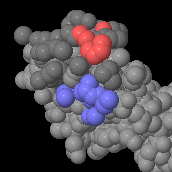What are FirstGlance in Jmol and Pepitope?
Beginning with version 1.3 (January, 2007), FirstGlance in Jmol can display Pepitope results. (Earlier, in August 2006, FirstGlance in Jmol was adapted to display results from the ConSurf Server.)
The remainder of this document concerns the use of FirstGlance in Jmol for viewing Pepitope results.
Changing from the Pepitope to the FirstGlance control panel -- and back.
Once you enter the main FirstGlance in Jmol control panel, there is always a link (Pepitope Controls) near the middle of the left side that takes you back. Thus, you can move freely back and forth between the two control panels.
FirstGlance offers you views of the molecule (unrelated to epitopes) that will help you understand the molecular structure in greater detail.
Some of the views in FirstGlance can use the Pepitope colors, as an alternative to their usual colors. You can control which color scheme is used with the checkbox (Pepitope Colors) near the left middle.
Hiding and finding portions of the molecule.
A Hide.. dialog is available in the FirstGlance control panel. Here, you can hide portions of the molecule by clicking on them. The hidden portions remain hidden in all other views, including views obtained at the Pepitope control panel, until you re-enter the Hide.. dialog and explicitly re-display them (or click Reset in the FirstGlance control panel).
Salt Bridges and Cation-Pi Orbital interactions.
 |
(red and blue) in the dark gray chain are in contact with the light gray chain. |
A special checkbox is provided, Color Target Gray. This may make it easier to visualize the Pepitope colors in the atoms contacting the target.